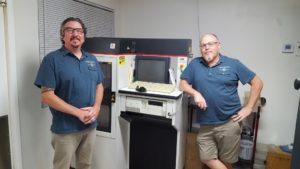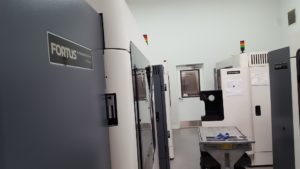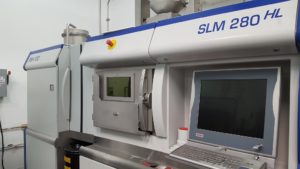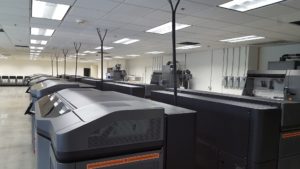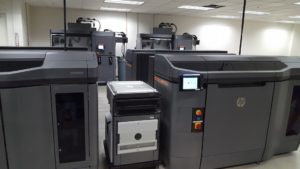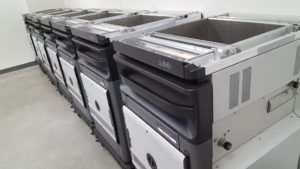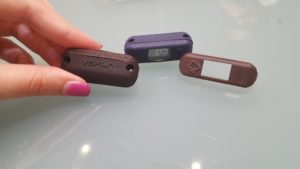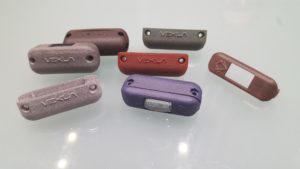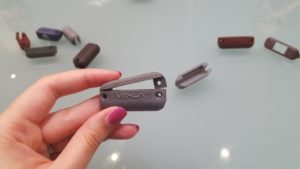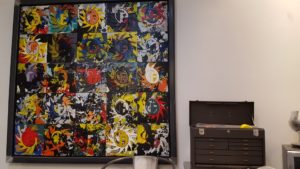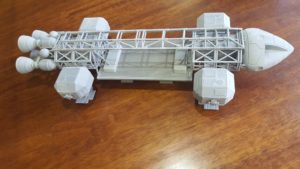 Carlsbad, California-based Forecast 3D recently made a major investment, bringing in a full dozen HP Jet Fusion 3D printers this summer to form the foundation of its newly-created 3D Manufacturing Center. Multi Jet Fusion 3D printing technology is at the heart of the operations in this facility, joining the broad array of other, primarily additive, manufacturing technologies the busy company offers.
Carlsbad, California-based Forecast 3D recently made a major investment, bringing in a full dozen HP Jet Fusion 3D printers this summer to form the foundation of its newly-created 3D Manufacturing Center. Multi Jet Fusion 3D printing technology is at the heart of the operations in this facility, joining the broad array of other, primarily additive, manufacturing technologies the busy company offers.
Recently at their facilities, Forecast 3D CEO Corey Weber, COO Donovan Weber, Technical Sales Director Ken Burns, and Director of Marketing Kimi Cañete led a private tour as another journalist and I visited for the first time. Forecast 3D is a familiar force in additive manufacturing today, as the company, founded by the brothers Weber in 1994, has long been working with various 3D printers as part of day-to-day operations. Corey and Donovan pointed out their very first SLA 3D printer as we went around the several rooms housing industrial equipment, as the machine stood near its later-generation successors.
- Donovan (L) and Corey Weber with the first 3D printer they brought in…
- …and with a build unit from their most recent 3D printing investment
- A blast from the 3D Systems past…
- …and from earlier-generation Stratasys
In the decades that Forecast 3D has been in operation, the team has borne witness to the many changes in 3D printing technologies with each passing year.
The recent updates have changed things around a bit, but for a look at much of what I saw on-site in Carlsbad, check out this video tour from the Forecast 3D team:
Additive manufacturing is enhancing offerings to customers, as a wider array of technologies allow for more design freedom and complexity. Design for additive manufacturing (DfAM) opens more possibilities, as the team underscored.
“MJF in particular opens up a lot more for designers, with more accessible CAD,” Corey explained.
He turned to a customer story as an example, noting that Forecast 3D has worked with Knuckledragger Design to create internal components for their communications equipment designs. MJF 3D printing technology and the accompanying freedoms of design possible in DfAM allows for “better designs, newer designs,” as explained in the below video:
Care for customers and their unique needs came across through every step of the facility tour, as Corey, Donovan, Ken, and Kimi walked us through each manufacturing area. A variety of familiar refrains came up as they discussed the merits of investing more heavily into additive manufacturing among their service offerings. Unique geometries never before possible, faster turnaround time, lower material costs, and more are often among the top-billed pros for the technology, and all for good reason as these are tangible aspects from which businesses stand to benefit. Advances in the technology are bringing these possibilities to more companies’ attention, especially as we see the move toward production-level additive manufacturing.
One of the most notable benefits of designing for MJF technology is that parts can be nested together for larger quantities made in a single build. Just ahead of my visit to Carlsbad, I spent a few days in Silicon Valley with HP Inc., where Market Development Manager David Tucker spoke to a small group of press and analysts about DfAM with MJF as part of the announcement of HP’s expanding partnership with Deloitte.
“How do we get to tomorrow?” he asked. “When we talk about tomorrow, we’re talking about 3D printing and additive manufacturing applications. We need to talk about design, keeping in mind we’re on this bridge to tomorrow. As a product designer, there’s two things that matter to a process: How does it work? How do you design for that technology? If you don’t know those two things, you’ll never get to adoption.”
Of MJF technology and its separate build unit, he noted, “This system is designed architecturally with manufacturing in mind.”
An important part of HP’s approach to, as they put it, reinventing manufacturing, involves starting with a clean sheet, as they note that MJF allows for printed layer optimization and packing density optimization, as well as:
- Balanced capacity
- Flexible manufacturing platform
- Limited fixed cost investment
- Schedule flexibility
- Scalable
- Minimal waste
- Parts delivered JIT
 Tucker described the Kanban method, a just-in-time (JIT) method of inventory control originally developed in Japanese automotive factories. Employing this method, he noted, allows engineers to design for manufacturing optimization during the design phase, increasing build density, improving capability, and optimizing capital resources. Taking advantage of as much of the build area as possible eases the way toward production-scale manufacturing with additive technologies — an advantage that Forecast 3D is very interested in as they scale their capabilities. The nesting capabilities for design allowed for by the Kanban method let designers enhance their use of available printing capacity, an obvious benefit in production-level creation for products at various price points and complexities.
Tucker described the Kanban method, a just-in-time (JIT) method of inventory control originally developed in Japanese automotive factories. Employing this method, he noted, allows engineers to design for manufacturing optimization during the design phase, increasing build density, improving capability, and optimizing capital resources. Taking advantage of as much of the build area as possible eases the way toward production-scale manufacturing with additive technologies — an advantage that Forecast 3D is very interested in as they scale their capabilities. The nesting capabilities for design allowed for by the Kanban method let designers enhance their use of available printing capacity, an obvious benefit in production-level creation for products at various price points and complexities.
“It doesn’t have to be a high-value product we make, so many more products are made possible,” Corey explained.
Corey, who is a fan of the delightfully whimsical theory of “3D printduction” — a term for 3D printing for production his brother maintains will never take off — noted that the capacity in the company’s new 3D Manufacturing Center is a major step toward achieving scale production.
Additive manufacturing is visible throughout the facilities at Forecast 3D, including machines from 3D Systems, Stratasys, SLM Solutions, and more alongside CNC and other subtractive machines, urethane casting operations, paint booths, a wood shop, and other workshop machinery and setups for the busy team. Primarily featuring SLA, FDM, and some SLM, SLS, and DMLS technologies, the investment into MJF shows the step into a new technology and continued interest in 3D printing.
“We heavily invested in SLS before, but now it’s really MJF,” Ken noted. “Warpage had been an issue, but much less now with MJF.”
The team explain their interest in MJF in this video:
With 12 HP 3D printers, 28 build units, and 5 post-processing stations, the 3D Manufacturing Center is housed in Forecast 3D’s new facility just across the street from the main building. The number of machines installed, particularly with the movable build units, “pretty much enables them to run all the time,” Corey noted.
“We iterate in production materials quickly,” Corey said. “We can go through four designs in a week and then the next week make the first production run on the same machines.”
Ken continued, “It’s really neat to go end-to-end so quickly.”
Corey picked the thought back up, noting that, “MJF is so fast, even injection molds make sense on this tech. It makes sense already, but then you add DfAM and the complexity possible… To optimize fully, additive makes it easier to design parts, as we don’t have those old rules to keep to.”
- Rows of running Jet Fusion 3D printers at Forecast 3D
- A line of build units ready for duty
- I was jazzed to be there
Corey did caution, though, that “We do definitely have a ways to go before the vast majority of customers will have heard of it.” Ken agreed that acceptance is the biggest block to wider use.
Showcasing customer parts successfully created using 3D technologies is an important step for enhancing the rate of adoption for additive manufacturing across industry. Case studies are a critical way to show, rather than tell, what 3D printing is capable of today, in real-world conditions. While many customers require that their projects remain confidential, those willing to share how they employ 3D printing offer a valuable service in their own right to highlight the rising capabilities of this increasingly better understood method of production. One such case Forecast 3D could show off was a 3D printed case for watches leashed to surfboards. Hey, it’s California.
VEKLA makes surf leash watches (“for the minimalist surfer”) and soon, the final product will be 3D printed using MJF technology. Injection molding was used first, but the second design was made with MJF. Showcasing what the Forecast 3D team described as “truly JIT” capabilities, the MJF-made watch cases were in hand, finished, in two days for a lower cost than the traditionally molded cases — which came with an eight-week wait and about an $8,000 tag. The watch cases at hand at Forecast 3D were in a variety of colors; these were made in grey before being dyed with deep colors to get into the material. They report no issues holding up in tough surf usage.
“For small business, this is such a nice tech,” Kimi said as we looked at the VEKLA cases. “You can come up with a new product, which to launch needs thousands of dollars, all betting on this product that’s not proven yet. With MJF, you can start with $300 and make 50 units, and start selling them next week. Small companies don’t have that safety net usually, but now there’s no risk.”
Of course, the answer will never be completely additive as the younger technology takes its place among a full workshop of tools in production. The team at Forecast 3D were quick to note that subtractive methods support their additive activities, and that “tooling will never go away.”
“We want to offer solutions our customers need, and not shoehorn them into a certain technology,” Donovan noted of their approach to incorporating additive into regular offerings. “We ask questions first, learn constraints, and can make decisions and recommendations from there.”
 Forecast 3D’s operations are notable in that their activities, so far as they know, have made them the largest privately held additive manufacturing-focused company in the US.
Forecast 3D’s operations are notable in that their activities, so far as they know, have made them the largest privately held additive manufacturing-focused company in the US.
The look into and walk through facilities in Carlsbad was eye-opening. The 3D printing capabilities Forecast 3D offers do fit seamlessly into their larger workflow, and the company maintains a realistic, level-headed (and jovial) attitude regarding their offerings for a broad variety of customers and applications, as they continue to champion the technology and serve as an example.
- Fusion 3D has a lot of personality from the moment you step through the front door
- Complex geometries made possible via 3D printing
Discuss this story and other 3D printing topics at 3DPrintBoard.com, or share your comments below.
[All photos: Sarah Goehrke / Videos: HP/Forecast 3D]
Subscribe to Our Email Newsletter
Stay up-to-date on all the latest news from the 3D printing industry and receive information and offers from third party vendors.
You May Also Like
US Army Corps of Engineers Taps Lincoln Electric & Eaton for Largest 3D Printed US Civil Works Part
The Soo Locks sit on the US-Canadian border, enabling maritime travel between Lake Superior and Lake Huron, from which ships can reach the rest of the Great Lakes. Crafts carrying...
Construction 3D Printing CEO Reflects on Being Female in Construction
Natalie Wadley, CEO of ChangeMaker3D, could hear the words of her daughter sitting next to her resounding in her head. “Mum, MUM, you’ve won!” Wadley had just won the prestigious...
Blue Laser-powered M600 3D Printer Launched by Meltio
Founded in 2019 as a joint venture between Additec and Sicnova, metal 3D printer OEM Meltio develops and manufactures high-performance and easy-to-use metal 3D printing solutions that use its patented wire-laser metal...
3D Printed Storage Tanks Cut Material Costs by 25%
In a previous article, “Concrete Dreams: Let’s Print Money, Not Houses,” we discussed how the spotlight on 3D printing homes might be misplaced. Bollards, pedestrian bridges, and concrete tanks could...


